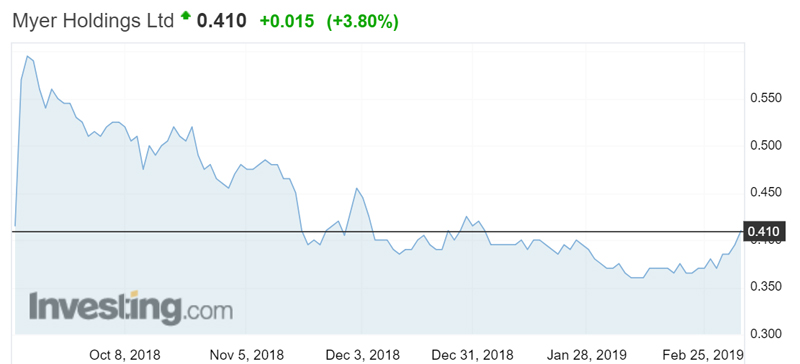Myer actually fought back with a profit – but it’s still stuck in small cap land

Picture: Getty Images
Smallcap retailer Myer (ASX:MYR) says sales are still going down, by 2.8 per cent in the last six months.
But there was a sign of life in the old bird: it made a profit.
Myer reported a $37.3m profit for the six months to December 31, inarguably better than the $476m loss it handed to shareholders in the same period in 2017.
The reason for that was not because the company is doing any better as a retailer.
Today, the company said sales were $1.7 billion buoyed by the company’s largest store — its website.
The turnaround was because in the same period in 2017, Myer had to put $538m in restructuring, store exit costs and impairments on its books.
This time, those costs were just $4.8m.
The once-glorious department store has struggled for a decade. Department store sales generally across the market began to stagnate in 2009, according to the Australian Bureau of Statistics, a year before Myer was spun off from Coles.
They’ve had a string of men at the helm who have consistently failed to bring the grand old lady back from the brink, and a string of strategies to entice shoppers back. The latest battle is the long-running Soloman Lew-led takeover attacks, which still continue.

Myer’s new CEO and managing director John King said the results, which included less bad quarterly sales declines in the December quarter compared to the September period, were a result of the ‘customer first’ plan.
“There are a number of Customer First pilots underway across multiple stores to determine the customer response to new brands, preferred store layouts, brand adjacencies and marketing, which will enable us to roll out these improvements to further stores.
“The debt refinancing was completed in November 2018 and provides a stable platform for the next two years, with substantial headroom in all of our covenants,” he said.
“We remain focused on deleveraging and net debt was reduced by $57 million.”
They are also cutting costs “that do not directly benefit the customer”.
Myer is not suggesting the next half year results will bring cheer to customers.
Sales are expected to hurt as “a number” of brands cut ties with the retailer, but it is bringing in others as replacements.
Higher interest and depreciation costs will continue, and they’re worried about the federal election and moderating housing market affecting spending.
UNLOCK INSIGHTS
Discover the untold stories of emerging ASX stocks.
Daily news and expert analysis, it's free to subscribe.
By proceeding, you confirm you understand that we handle personal information in accordance with our Privacy Policy.








